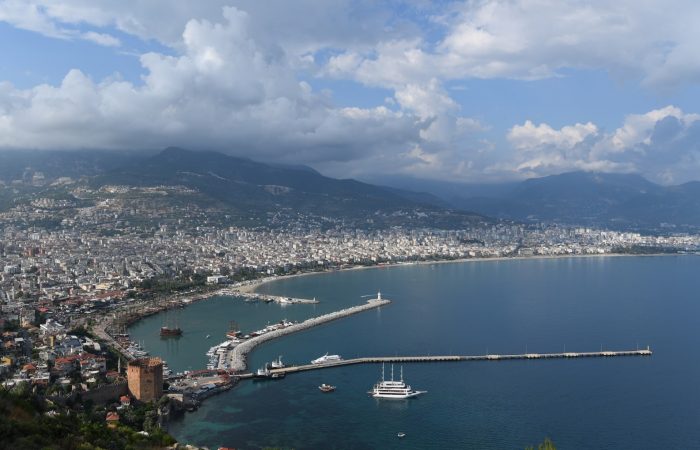Obtaining and maintaining secure and diverse transportation routes have always been essential for the growth of an empire, nation, or state. Rome built its fortune on securing such routes as it expanded its empire throughout centuries. The Byzantine, Ottoman, Spanish, Dutch and British empires greatly benefited from–or even owed their success to–securing their own trade and communication routes, often in the form of sea lines of communication and maritime port establishments.
Ports as political gateways
Aside from obvious economic benefits, ports are commonly used politically as gateways into a foreign land. When a nation or empire wanted to build influence over a region, a typical first step was to establish power over a strategically-located foreign port. In the Treaty of Nanking (1842), the first of multiple unequal treaties with China in the 19th and 20th centuries, the British seized control over Hong Kong Island and announced five other Chinese port cities would be open to foreign trade. In the 1850s, U.S. Commodore Matthew Perry used a series of tactics to establish regular trade relations with the Government of Japan, which centered around opening two Japanese ports for American use. As the Russian and Japanese empires were competing over Korea and China at the turn of the 20th Century, Japan targeted the strategic naval base of Port Arthur in modern-day Manchuria, forcing Russia to transfer the lease of Port Arthur and its surrounding Liaodong Peninsula to the Empire of Japan. The historical precedence and strategic success of port seizures in grand strategy can turn a modern observer to ask: Is the strategy of foreign port acquisitions as a means to influence foreign powers still being utilized today?
In answer: Port control is still a valuable tactic used today, but its appearance has evolved alongside globalization. Since the end of World War II, the world has begun to fall away from a world of empires towards a world of collaborative nation-states. Inherently, spreading the ideals of democracy, equality and peace are no longer congruent with seizures of ports through questionable tactics or as conquests of war. In the modern era, securing port power in a foreign country is conducted mainly through lease agreements that appear to be mutually beneficial. Still, much can be inferred from port diplomacy and the ports themselves can be seen as a ‘sneak peak’ into a nation-states’ end designs for a region.
Paying attention to details can pay off
With enough credible facts and data, the end-use of a port can be assumed–or at least narrowed down. Ports are built for specific purposes–commercial, military, security, leisure, etc.–and with the right observations and intelligence a nation’s intent for the region can be discerned. The following are some questions to consider when looking at a maritime port.
Who owns the port? As previously mentioned, many maritime ports are obtained through leasing contracts. Awareness of the details of these agreements–namely, the length of the agreement and allowances therein–can be indicators of the power dynamics between the two parties. If a nation is building a port in their own territory or claimed territory, there are far fewer limitations to the intended end-use or stipulations that must be kept in regard to port operations.
What is the water depth or other measures of bathymetry? Like the length or material makeup of an airport runway, the depth of a maritime port can indicate the type or even model of the ship that port can support and, therefore, the potential cargo load that is intended to pass through the port. Most non-littoral naval vessels cannot operate in shallow waters (less than 14 feet of water) due to their draft–the depth of the water line to the bottom of the hull. Regular ports are 20 feet deep, while deepwater ports typically exceed 30 feet in depth. Even within ship class, draft can differ greatly and is affected by various factors. For context, the draft of a typical cruise ship can vary between 25 feet and 50 feet due to displacement and design. The U.S. Coast Guard’s heavy icebreakers that operate in the Arctic regions have a 28-foot draft, while its counterparts used in the Great Lakes have 16-foot drafts. Some of the Coast Guard’s smaller cutters and patrol boats have 5-7-foot drafts. Knowing the depth of a maritime port–or acknowledging water-control actions like dredging or dam building that extend the depth or width of the water channel–could prove to be an important clue in predicting end-use.
What is the size and makeup of the dock itself? If the docking area can support the weight of heavy cranes and has large swathes of open areas, perhaps the port is primarily for containerized cargo or bulk cargo. If the port area is limited, such as China’s 0.5 sq. km. port in Djibouti in the Horn of Africa, it becomes clear that the primary use is not for large-scale commercial or storage purposes.
What activity occurs around the port? t? Is there open information about the types of vessels making berth at a port or the goods that transit the port? Are navy or coast guard vessels stopping at the port–or commonly sail past it–or is it primarily trade, fishing, natural gas, or another kind of commercial vessel? Are there personnel stationed at the port, potentially for security reasons? Furthermore, ports cost money, manpower, and effort to maintain, and governments have limited budgets. If a port is being maintained–or is receiving renewed attention by the government like some ports in the Polar regions have in recent years–this is a clear indication of some level of interest in the region and potential preparation for future grand strategic goals.
How quickly was the port developed? Resources are inherently precious, so when a government places serious efforts to complete a project in a small time frame, this should be noted and questioned by observers. Many researchers have remarked on the rapid building of ports by the Chinese government on contested features in the South China Sea and have related the rapid development to Chinese concerns of solidifying their highly controversial territorial and maritime rights claims.
These questions are not meant to bubble up unfounded suspicions or formulate controversial theories. Ports can be powerful collaborative tools and useful for gaining insights into the bilateral relationship between two countries. Simultaneously, maritime ports are important tools in regional strategy prediction. Furthermore, with access to modern tools like the Internet, observers can witness their construction and usage more easily than ever before. Sometimes these observations seem too obvious or pointless to make, but each data point can build into significant trends when pieced together. Narrowing down the potential end-goals of a port and combining it with a larger understanding of a nation-state’s goals in a region could prove to be a valuable puzzle piece in understanding its grand strategy.




